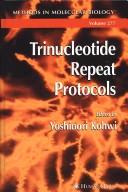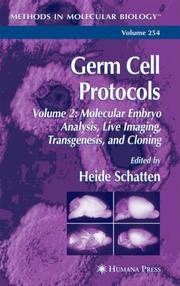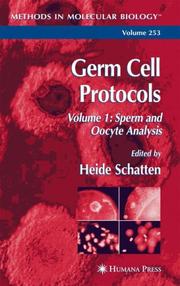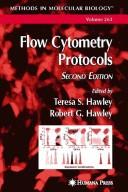| Listing 1 - 10 of 154 | << page >> |
Sort by
|

ISBN: 128036050X 9786610360505 1592597467 1588292266 Year: 2004 Publisher: Totowa, NJ : Humana Press : Imprint: Humana,
Abstract | Keywords | Export | Availability | Bookmark
 Loading...
Loading...Choose an application
- Reference Manager
- EndNote
- RefWorks (Direct export to RefWorks)
In this completely updated and expanded edition of a classic bench manual, hands-on experts take advantage of the latest advances in ribozyme, DNAzyme, hammerhead ribozymes and derivatives, and RNA interference technologies to describe in detail the exciting and successful methods now available for gene inactivation in vitro and in vivo. Their optimized techniques employ hairpin ribozymes, DNAzymes, hammerhead ribozymes and derivatives, group I intron ribozymes, RNase P ribozymes, and siRNAs, as well as general methods for RNA structure analysis, delivery of oligonucleotides, and gene therapy. Also provided are novel methods for identifying accessible cellular mRNA sites; group I intron and RNAse P ribozyme protocols for effective design, selection, and therapeutic applications; and the latest RNAi methods for sequence-specific gene silencing in a wide variety of organisms. Additional techniques cover the analysis of ribozyme structures and conformational transitions using nucleotide analog interference mapping and fluorescence resonance energy transfer, the use of ribozymes in clinical and gene therapy, and the use of ribozymes and DNAzymes in rodent models of human disease. Each proven protocol includes a background introduction outlining the principle behind the technique, step-by-step instructions, lists of equipment and reagents, and tips on troubleshooting and avoiding known pitfalls. Comprehensive and up-to-date, Ribozymes and siRNA Protocols details for experienced and novice investigators alike the many exciting advances in our understanding of nucleic acid enzymes, as well as demonstrating how they may be used to analyze gene function and target validation, and to productively develop novel therapeutics for human diseases.
Cytology. --- Cell Biology. --- Cell biology --- Cellular biology --- Biology --- Cells --- Cytologists

ISBN: 1280360461 9786610360468 1592597513 1588292207 Year: 2004 Publisher: Totowa, NJ : Humana Press : Imprint: Humana,
Abstract | Keywords | Export | Availability | Bookmark
 Loading...
Loading...Choose an application
- Reference Manager
- EndNote
- RefWorks (Direct export to RefWorks)
The transcription of messenger RNA from a DNA template is a key process in a wide variety of biological systems. In Gene Expression Profiling: Methods and Protocols, leaders in gene expression methodology and bioinformatics data analysis share their best methods for measuring RNA levels in cells and tissues. Each proven protocol is described in step-by-step detail and contains an introduction outlining the principle behind the technique, lists of equipment and reagents, and tips on troubleshooting and avoiding known pitfalls. Special care has been taken to distill the basic underlying principles of each method to a few straightforward concepts so that investigators can easily choose the method most appropriate to their application. The readily reproducible techniques presented include new methods for applying the GeneChip®, SAR-SAGE, StaRT-PCR, SSH, the Invader Assay®, and ADGEM. The authors also provide critical bioinformatics insight and resources for data analysis and management. Cutting-edge and highly practical, Gene Expression Profiling: Methods and Protocols allows novice and experienced investigators alike not only to choose the best method to determine how genes are turned on and off in many different organisms, but also to use informatics resources to analyze and understand the results.
Cytology. --- Cell Biology. --- Cell biology --- Cellular biology --- Biology --- Cells --- Cytologists

ISBN: 1280360011 9786610360017 1592598048 1588292436 Year: 2004 Publisher: Totowa, NJ : Humana Press : Imprint: Humana,
Abstract | Keywords | Export | Availability | Bookmark
 Loading...
Loading...Choose an application
- Reference Manager
- EndNote
- RefWorks (Direct export to RefWorks)
The discovery that trinucleotide repeats significantly influence the age of onset and severity of a variety of hereditary neurological disorders has opened the door to a deeper understanding of the disease mechanisms involved, as well as to a more productive search for novel therapeutic interventions. In Trinucleotide Repeat Protocols, established leaders in trinucleotide repeat disease describe in step-by-step detail their best techniques for studying trinucleotide pathology at the molecular level. The protocols cover a variety of targets, ranging from DNA and RNA to proteins and whole animals, and focus not only on causal genes, but also on their consequent products, such as transcription factors, neurotransmitter receptors, proteasomes, and mitochondria/oxidation damage. Experimental systems employed include E. coli, yeast, C. elegans, mouse, and generally take a clinical point of view. The authors utilize a wide range of techniques, including gel electrophoresis, quantitative RT-PCR, immunological analysis, antibody usage and its applications, receptor assays using radioisotope handling, gene delivery by virus, brain cell and organotypic cultures, gender dependency, and neuron structure analysis. Each protocol follows the successful Methods in Molecular Biology™ series format, offering step-by-step laboratory instructions, an introduction outlining the principle behind the technique, lists of the necessary equipment and reagents, and tips on troubleshooting and avoiding known pitfalls. Cutting-edge and highly practical, Trinucleotide Repeat Protocols offers neuroscientists powerful tools to elucidate both normal brain function and the mechanisms of hereditary neurological disease, as well as to develop the next generation of therapies for neuronal genetic diseases.
Cytology. --- Cell Biology. --- Cell biology --- Cellular biology --- Biology --- Cells --- Cytologists

ISBN: 1280360534 9786610360536 1592597416 1588292576 Year: 2004 Publisher: Totowa, NJ : Humana Press : Imprint: Humana,
Abstract | Keywords | Export | Availability | Bookmark
 Loading...
Loading...Choose an application
- Reference Manager
- EndNote
- RefWorks (Direct export to RefWorks)
Germ cell research has produced enormous advances in recent years and more recently has entered into an explosive phase of new discoveries with the introduction of transgenic technologies and nuclear cloning. In Germ Cell Protocols, expert laboratory investigators describe in step-by-step detail a series of powerful techniques for the molecular and genetic analysis of germ cells in a variety of different reproductive systems. Chosen for their proven success in advancing our understanding of germ cells, these methods cover sperm and egg activation, motility, fertilization, nuclear development, nuclear cloning, the molecular characterization of specific events, the imaging of cell structures, and the cryopreservation of germ cells. Volume 2: Molecular Embryo Analysis, Live Imaging, Transgenesis, and Cloning focuses on molecular egg analysis, live egg imaging, nuclear cloning, oocyte cryopreservation, and nuclear transfer. Highlights include the identification and characterization of Oct-4, germline chromatin silencing by RNAi, cDNA subtraction and cloning in the field of trophoblast/placental development, and selective ablation. There are also methods for PCR-based cloning, differentiating embryonic stem cells into embryonic bodies, live imaging of mammalian embryos using multiphoton microscopy, and the cloning of pig, cattle, rabbit, and mouse oocytes. Each readily reproducible protocol is described in step-by-step detail and contains an introduction outlining the principle behind the technique, lists of equipment and reagents, and tips on troubleshooting and avoiding known pitfalls. An accompanying earlier volume, Sperm and Oocyte Analysis, focuses on sperm cells, oocyte analysis, oocyte maturation, fertilization, and preparation techniques. Comprehensive and cutting-edge, Germ Cell Protocols offers both novice and established researchers a gold-standard collection of hard-to-find methods for high impact research, diverse procedures that are easy-to-follow, well-illustrated, and allow a cross-species transfer of knowledge from lower vertebrates to higher mammalian systems.
Cytology. --- Cell Biology. --- Cell biology --- Cellular biology --- Biology --- Cells --- Cytologists

ISBN: 1280360526 9786610360529 1592597440 1588291219 Year: 2004 Publisher: Totowa, NJ : Humana Press : Imprint: Humana,
Abstract | Keywords | Export | Availability | Bookmark
 Loading...
Loading...Choose an application
- Reference Manager
- EndNote
- RefWorks (Direct export to RefWorks)
Germ cell research has produced enormous advances in recent years and more recently has entered into an explosive phase of new discoveries with the introduction of transgenic technologies and nuclear cloning. In Germ Cell Protocols, expert laboratory investigators describe in step-by-step detail a series of powerful techniques for the molecular and genetic analysis of germ cells in a variety of different reproductive systems. Chosen for their proven success in advancing our understanding of germ cells, these methods cover sperm and egg activation, motility, fertilization, nuclear development, nuclear cloning, the molecular characterization of specific events, and the imaging of cell structures. Volume 1: Sperm and Oocyte Analysis focuses on sperm cells, oocyte analysis, oocyte maturation, fertilization, and preparation techniques. Highlights include in vitro maturation and fertilization of human, porcine, and canine oocytes; the cryopreservation of sperm cells; establishment of an in vitro spermatogenesis system; visualization of sperm accessory structures; and motility assays of spermatozoa. Each readily reproducible protocol is described in step-by-step detail and contains an introduction outlining the principle behind the technique, lists of equipment and reagents, and tips on troubleshooting and avoiding known pitfalls. An accompanying second volume, Molecular Embryo Analysis, Live Imaging, Transgenesis, and Cloning, contains methods for molecular egg analysis, live egg imaging, nuclear cloning, oocyte preservation, and nuclear transfer. Comprehensive and cutting-edge, Germ Cell Protocols offers both novice and established researchers a gold-standard collection of hard-to-find methods for high impact research, diverse procedures that are easy-to-follow, well-illustrated, and allow a cross-species transfer of knowledge from lower vertebrates to higher mammalian systems.
Cytology. --- Cell Biology. --- Cell biology --- Cellular biology --- Biology --- Cells --- Cytologists

ISBN: 1280843101 9786610843107 1592596460 1588291154 Year: 2004 Publisher: Totowa, NJ : Humana Press : Imprint: Humana,
Abstract | Keywords | Export | Availability | Bookmark
 Loading...
Loading...Choose an application
- Reference Manager
- EndNote
- RefWorks (Direct export to RefWorks)
In recent years, cell cycle checkpoints, cellular mechanisms that control the cell cycle and ensure genomic stability, have emerged as significant factors in carcinogenesis and in cancer cells. In Cell Cycle Checkpoint Control Protocols, leading investigators present their best methodologies to probe the mechanisms underlying cell cycle regulation and checkpoint control. Using mammalian, yeast, and frog systems, these experts describe readily reproducible methods to induce cell cycle checkpoints, detect changes in cell cycle progression, identify and analyze genes and proteins that regulate the process, and characterize chromosomal status as a function of cell cycle phase and progression. Each fully tested technique includes step-by-step instructions written by an investigator who performs it frequently, an introduction explaining the principle behind the method, equipment and reagent lists, and tips on troubleshooting and avoiding known pitfalls. Taken as a whole, the collection describes the major methodologies used by researchers in the field. Cutting-edge and highly practical, Cell Cycle Checkpoint Control Protocols provides an extensive array of detailed protocols by which both experienced and novice investigators may successfully illuminate questions concerning cell cycle control.
Cytology. --- Cell Biology. --- Cell biology --- Cellular biology --- Biology --- Cells --- Cytologists

ISBN: 1280359927 9786610359929 1592598137 1588290980 Year: 2004 Publisher: Totowa, NJ : Humana Press : Imprint: Humana,
Abstract | Keywords | Export | Availability | Bookmark
 Loading...
Loading...Choose an application
- Reference Manager
- EndNote
- RefWorks (Direct export to RefWorks)
Contemporary approaches to the synthesis of chemically modified proteins not only require efficient means to control conjugation and the specific site of attachment of the conjugated moiety, but also the effective use of recent developments in microarray technologies and nanobiotechnology. In Bioconjugation Protocols: Strategies and Methods, expert laboratorians update the classic methods and introduce valuable new approaches that go beyond basic conjugation techniques to include elements from advanced organic synthesis, molecular biology, and materials science. These readily reproducible methods cover the preparation of protein conjugates using covalent and noncovalent conjugation, the synthesis of nucleic acid conjugates using a variety of labeling techniques, and approaches to semisynthetic conjugates of proteins. Additional chapters address the biofunctionalization of inorganic surfaces, including the on-chip synthesis of peptide nucleic acids to generate microarrays for the high-throughput analysis of RNA and DNA, gold nanoparticles, and carbon nanotube probes for atomic force microscopy. All the protocols follow the successful Methods in Molecular Biology™ series format, each one offering step-by-step laboratory instructions, an introduction outlining the principle behind the technique, lists of the necessary equipment and reagents, and tips on troubleshooting and avoiding known pitfalls. Cutting-edge and highly practical, Bioconjugation Protocols: Strategies and Methods offers both novice and experienced researchers access to the broad array of techniques needed to master the semisynthesis of functional biomolecular reagents for a wide variety of applications-ranging from novel biomedical diagnostics, to powerful new therapeutics, to advanced biomaterials.
Cytology. --- Cell Biology. --- Cell biology --- Cellular biology --- Biology --- Cells --- Cytologists

ISBN: 1280360283 9786610360284 1592597734 1588292347 Year: 2004 Publisher: Totowa, NJ : Humana Press : Imprint: Humana,
Abstract | Keywords | Export | Availability | Bookmark
 Loading...
Loading...Choose an application
- Reference Manager
- EndNote
- RefWorks (Direct export to RefWorks)
In this thoroughly revised and updated edition of a widely used practical guide to flow cytometry, leading experimentalists describe in step-by-step detail an array of time-proven and cutting-edge techniques much needed in today's advanced laboratories. These readily reproducible methods deploy emerging flow cytometry technologies in many new applications, especially in the fields of stem cells, functional genomics and proteomics, and microbiology. Here, the aspiring investigator will find methods for the characterization of stem/progenitor cells by monitoring the efflux of fluorescent dyes and the elucidation of signal transduction pathways using phospho-specific antibodies. There are also techniques for monitoring gene transfer and expression using fluorescent protein technology, high-throughput screening for discovery of novel protein interactions, phenotypic and functional characterization of T-cell subsets and precursors, and microbial flow cytometry, to highlight but some of the many useful procedures. The protocols presented follow the successful Methods in Molecular Biology™ series format, each one offering step-by-step laboratory instructions, an introduction outlining the principle behind the technique, lists of equipment and reagents, and tips on troubleshooting and avoiding known pitfalls. Comprehensive and highly practical, Flow Cytometry Protocols, Second Edition offers both basic and clinical scientists an up-to-date collection of cutting-edge protocols for solving the widest variety of novel flow cytometry problems.
Cytology. --- Cell Biology. --- Cell biology --- Cellular biology --- Biology --- Cells --- Cytologists

ISBN: 1280360445 9786610360444 1592597548 1588293297 Year: 2004 Publisher: Totowa, NJ : Humana Press : Imprint: Humana,
Abstract | Keywords | Export | Availability | Bookmark
 Loading...
Loading...Choose an application
- Reference Manager
- EndNote
- RefWorks (Direct export to RefWorks)
In this second edition of a widely appreciated work, Receptor Signal Transduction Protocols, a panel of internationally recognized investigators presents their best methods for studying G-protein-coupled receptors (GPCRs) and events immediately downstream of their activation. This new edition combines updates of key chapters from the first edition with a large number of new contributions on the many successful methodologies that have emerged more recently. The methods are focused primarily on events at the receptor level, including ligand binding, on the genetic manipulation of receptors, the generation of model cell lines in which to study them, and the interaction and activation of G-proteins. Additional methods concentrate on receptor expression and localization, receptor internalization and post-translational modification, GPCR-protein interactions, and the use of knock-out and knock-in strategies for determining the physiological roles of receptors. The laboratory protocols follow the successful Methods in Molecular Biology™ series format, each one offering step-by-step laboratory instructions, an introduction outlining the principle behind the technique, lists of equipment and reagents, and tips on troubleshooting and avoiding known pitfalls. Comprehensive and highly practical, Receptor Signal Transduction Protocols, Second Edition offers both novice and experienced investigators powerful cutting-edge techniques that provide an array of approaches and specific methods that will aid in the understanding of GPCR structure and function.
Cytology. --- Cell Biology. --- Cell biology --- Cellular biology --- Biology --- Cells --- Cytologists

ISBN: 1280360364 9786610360369 1592597637 1588292185 Year: 2004 Publisher: Totowa, NJ : Humana Press : Imprint: Humana,
Abstract | Keywords | Export | Availability | Bookmark
 Loading...
Loading...Choose an application
- Reference Manager
- EndNote
- RefWorks (Direct export to RefWorks)
It is essential that all clinical bacteriologists become active participants in the current genomics and proteomics revolution if the significant achievements of genome sequencing and analysis are to produce real benefits for patient care. In Genomics, Proteomics, and Clinical Bacteriology, a panel of internationally renowned experts reviews how genomics has provided novel methods for bacterial investigation and advanced our knowledge of bacterial pathogenicity. The authors critically evaluate the applications of genomics to diagnostic bacteriology, highlighting both current and likely future uses, describing real-time PCR methods, and outlining the promise of microarrays in clinical bacteriology. Their discussion examines in detail genomic approaches to antibacterial discovery, the nature of pathogenicity, the discovery of new pathogens, the exploration of the concept of clonality in bacteria, and bacterial taxonomics. Introductory material explains for the uninitiated the relevance of genomics to the clinical laboratory, illustrating the art and science of working with public databases, digging for data, and exploiting bacterial proteomes. Comprehensive and insightful, Genomics, Proteomics, and Clinical Bacteriology offers everyone working in medical bacteriology an accessible introduction to a rapidly evolving discipline, one that shows not only how knowledge of bacterial genome sequences affects diagnostic bacteriology today, but also how that knowledge may be used in the future to gain new insights into bacterial disease processes, identify critical targets for antiinfectives, and aid in designing novel antibiotics.
Microbiology. --- Microbial biology --- Biology --- Microorganisms
| Listing 1 - 10 of 154 | << page >> |
Sort by
|

 Search
Search Feedback
Feedback About
About Help
Help News
News